Mass spectra - Study guides, Class notes & Summaries
Looking for the best study guides, study notes and summaries about Mass spectra? On this page you'll find 175 study documents about Mass spectra.
Page 3 out of 175 results
Sort by
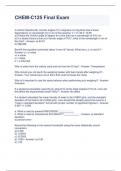
-
CHEM-C125 Final Exam Questions with Latest Update
- Exam (elaborations) • 23 pages • 2024
-
Available in package deal
-
- $16.49
- + learn more
In Atomic Spectra lab, Vernier angles (V) in degrees of a Hg-lamp has a linear dependence on wavelength (λ) in nm of line spectra: V = 0.146 λ−10.85 a) Predict the Vernier angle in degree for a line that has a wavelength of 510 nm. b) If a student found a line at a Vernier angle of 76.5°, what is the wavelength in nm of this line? - Answer- a) 63.61 b) 598.288 Best-fit line equation commonly takes "y=mx+b" format. What are y, x, m and b? - Answer- y = y-value x= x-value m = slope ...
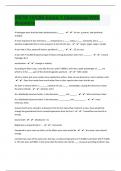
-
ASTR 181|96 Exam 1 Questions With Answers|2024
- Exam (elaborations) • 7 pages • 2024
-
- $7.99
- + learn more
A hydrogen atom that has been photoionized is _____. - ️️An ion, a proton, and positively charged. A main sequence O star will have a ___ temperature, a ____ radius, a ____ luminosity and a ____ absolute magnitude than a main sequence G star like the Sun. - ️️larger, larger, larger, smaller A star that is 50 pc away will show a parallax of _____. - ️️.02 arc secs A star with T=10,000 K (spectral type A) shows strong absorption lines from _______. - ️️neutral hydrogen (H I) ac...

-
AQA AS Physics Definitions Exam Questions and Answers 100% Pass
- Exam (elaborations) • 7 pages • 2024
-
- $11.49
- + learn more
AQA AS Physics Definitions Exam Questions and Answers 100% Pass Specific charge - Answer- the charge to mass ratio or charge in coulombs divided by the mass in kilograms Isotope - Answer- a nucleus with the same number of protons but different number of neutrons Hadron - Answer- a particle that experiences the strong nuclear force. Composite particles made of either qqq (baryons) or q anti-q (baryon) Antimatter - Answer- Particles with the same mass but opposite charge Photoelectric eff...
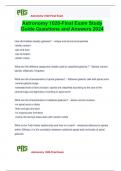
-
Astronomy 1020-Final Exam Study Guide Questions and Answers 2024
- Exam (elaborations) • 6 pages • 2024
-
- $12.99
- + learn more
How did Hubble classify galaxies? - -shape and structural properties -stellar content -gas and dust -star formation -stellar motion What are the different categories Hubble used to classified galaxies ? - Spirals, barred spirals, ellipticals, irregulars What are the characteristics of spiral galaxies? - -flattened galactic disk with spiral arms -central galactic bulge -extended halo of faint old stars -spirals are classified according to the size of the central bulge and tightness of...
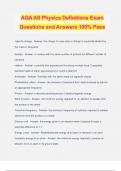
-
AQA AS Physics Definitions Exam Questions and Answers 100% Pass
- Exam (elaborations) • 7 pages • 2024
- Available in package deal
-
- $11.49
- + learn more
AQA AS Physics Definitions Exam Questions and Answers 100% Pass Specific charge - Answer- the charge to mass ratio or charge in coulombs divided by the mass in kilograms Isotope - Answer- a nucleus with the same number of protons but different number of neutrons Hadron - Answer- a particle that experiences the strong nuclear force. Composite particles made of either qqq (baryons) or q anti-q (baryon) Antimatter - Answer- Particles with the same mass but opposite charge Photoelectric eff...
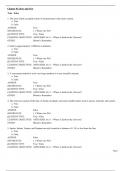
-
Test Bank for Foundations of Astronomy, 14th Edition by Michael A. Seeds
- Exam (elaborations) • 447 pages • 2023
-
- $29.49
- + learn more
Test Bank for Foundations of Astronomy, 14e 14th Edition by Michael A. Seeds, Dana Backman. Full Chapters test bank included Part 1: Exploring the Sky Chapter 1: Here and Now 1-1 Where Are We? 1-2 When Is Now? 1-3 Why Study Astronomy? Chapter 2: A User's Guide to the Sky 2-1 Stars and Constellations 2-2 The Sky and Celestial Motions 2-3 Sun and Planets 2-4 Astronomical Influences on Earth's Climate Chapter 3: Moon Phases and Eclipses 3-1 The Changeable Moon 3-2 Lunar Eclipses...
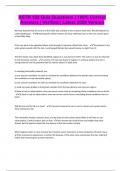
-
ASTR 102 Quiz Questions | 100% Correct Answers | Verified | Latest 2024 Version
- Exam (elaborations) • 21 pages • 2024
-
- $10.49
- + learn more
We have learned that the centre of the milky way contains a very massive black hole. We developed this understanding by: - Monitoring the orbital motions of many individual stars in the very central parts of the Milky Way If the sun were to be squashed down small enough to become a black hole, then: - The planets in the solar system would orbit the Sun in unchanged fashion (but would receive no light from it) The first stellar mass black hole identified, Cygnus X-1, was found in 1973. The n...
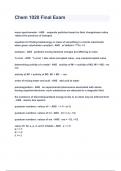
-
Chem 1020 Final Exam Questions And Answers
- Exam (elaborations) • 4 pages • 2023
-
- $10.49
- + learn more
Chem 1020 Final Exam Questions And Answers mass spectrometer - ANS -separate particles based on their charge/mass ratios -detect the presence of isotopes equation for finding heat/energy or mass of something in a bomb calorimeter when given calorimeter constant - ANS m*deltaH + T*Cc = 0 isotopes - ANS particles having identical charges but differing in mass % error - ANS % error = abs value (accepted value - exp value)/accepted value determining activity of a metal - ANS ...
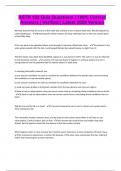
-
ASTR 102 Quiz Questions | 100% Correct Answers | Verified | Latest 2024 Version
- Exam (elaborations) • 21 pages • 2024
-
Available in package deal
-
- $10.45
- + learn more
ASTR 102 Quiz Questions | 100% Correct Answers | Verified | Latest 2024 Version We have learned that the centre of the milky way contains a very massive black hole. We developed this understanding by: - Monitoring the orbital motions of many individual stars in the very central parts of the Milky Way If the sun were to be squashed down small enough to become a black hole, then: - The planets in the solar system would orbit the Sun in unchanged fashion (but would receive no light from it)...
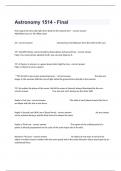
-
Astronomy 1514 - Final Real Exam Questions And Well Elaborated Answers.
- Exam (elaborations) • 11 pages • 2024
-
- $12.99
- + learn more
How long is the drive (60 mph) from Earth to the nearest star? - correct answer 400 billion hours or 50 million years AU - correct answer astronomical unit (distance from the earth to the sun) T/F: Scientific theory can be tested by observations and proved true - correct answer False; You cannot prove absolute truth, you can only disprove it. T/F: ...

How did he do that? By selling his study resources on Stuvia. Try it yourself! Discover all about earning on Stuvia


